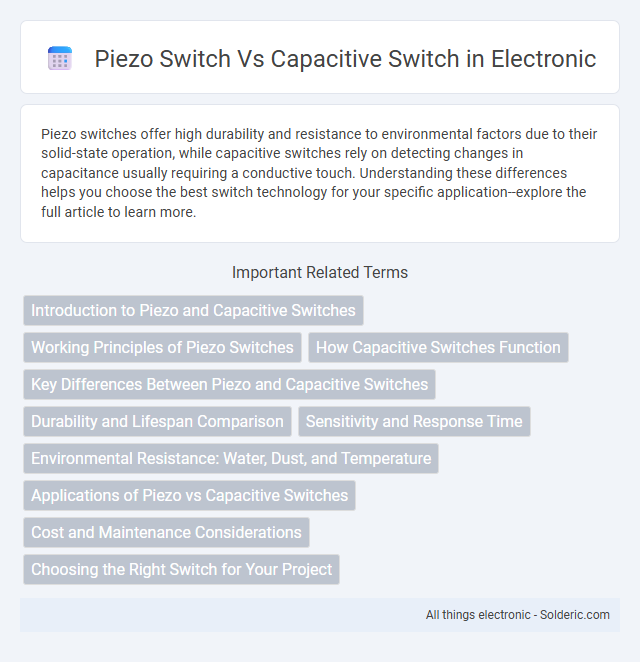Piezo switches offer high durability and resistance to environmental factors due to their solid-state operation, while capacitive switches rely on detecting changes in capacitance usually requiring a conductive touch. Understanding these differences helps you choose the best switch technology for your specific application--explore the full article to learn more.
Comparison Table
| Feature | Piezo Switch | Capacitive Switch |
|---|---|---|
| Activation Method | Pressure applied to piezoelectric material | Touch detected via change in capacitance |
| Durability | High, solid-state with no moving parts | Moderate, sensitive to environmental factors |
| Lifespan | Up to 1 billion activations | Typically 1-5 million activations |
| Water Resistance | Excellent, fully sealed design | Good, but can be affected by moisture |
| Power Consumption | Low, minimal power needed for switching | Moderate, requires continuous sensing |
| Operating Environment | Harsh environments, industrial use | Clean, dry environments preferred |
| Sensitivity | Responds to force/pressure | Responds to light touch |
| Application Examples | Industrial controls, medical devices, outdoor equipment | Consumer electronics, smartphones, touch panels |
Introduction to Piezo and Capacitive Switches
Piezo switches utilize piezoelectric materials that generate an electrical signal when mechanical pressure is applied, offering high durability and resistance to environmental factors like moisture and dust. Capacitive switches detect changes in electrical capacitance caused by the proximity or touch of your finger, providing a modern, sleek interface with no moving parts. Both technologies are widely used in industrial and consumer electronics, but piezo switches excel in harsh conditions, while capacitive switches prioritize seamless touch sensitivity and design flexibility.
Working Principles of Piezo Switches
Piezo switches operate based on the piezoelectric effect, where mechanical stress applied to a piezoelectric material generates an electrical charge that triggers a switch. Unlike capacitive switches that detect changes in capacitance from touch, piezo switches rely on pressure-induced deformation, enabling them to function reliably in harsh environments with dust, moisture, and dirt. This pressure-sensitive mechanism provides high durability and resistance to wear, making piezo switches ideal for industrial and outdoor applications.
How Capacitive Switches Function
Capacitive switches function by detecting changes in the electrostatic field caused by the presence of a finger or conductive object near the sensor surface, enabling touch-sensitive input without physical movement. Unlike piezo switches that rely on mechanical pressure to generate an electrical signal, capacitive switches measure variations in capacitance to trigger responses. Your choice between these switches should consider the need for durability, sensitivity, and the specific application environment.
Key Differences Between Piezo and Capacitive Switches
Piezo switches operate through mechanical pressure generating an electrical charge, offering high durability and resistance to environmental factors, while capacitive switches detect changes in capacitance caused by touch, providing a more sensitive and responsive user experience. Piezo switches excel in harsh conditions with a longer lifespan, whereas capacitive switches are ideal for sleek designs requiring multi-touch functionality and lower power consumption. Your choice depends on the application's environmental demands and the desired user interaction quality.
Durability and Lifespan Comparison
Piezo switches offer exceptional durability with lifespans exceeding 100 million actuations due to their solid-state design and lack of mechanical moving parts, making them highly resistant to wear and environmental factors. Capacitive switches, while sleek and responsive, typically have shorter lifespans around 10 to 50 million cycles due to their reliance on touch-sensitive surfaces that can degrade with prolonged use or exposure to contaminants. When durability and extended lifespan are critical for Your application, piezo switches provide a more reliable and maintenance-free solution compared to capacitive switches.
Sensitivity and Response Time
Piezo switches offer exceptional sensitivity by detecting mechanical pressure changes with a fast response time typically under 5 milliseconds, making them ideal for applications requiring quick, precise actuation. Capacitive switches rely on changes in the electric field caused by touch and generally have a slightly slower response time, around 10 to 20 milliseconds, but provide high sensitivity for detecting even a light touch without physical pressure. Your choice between piezo and capacitive switches depends on whether rapid mechanical input or gentle touch detection is more critical for the intended use.
Environmental Resistance: Water, Dust, and Temperature
Piezo switches exhibit exceptional environmental resistance, with IP67 or higher ratings providing robust protection against water, dust, and extreme temperatures, making them ideal for harsh industrial environments. Capacitive switches, while sensitive to moisture and contaminants, can achieve good environmental resistance but typically require additional sealing and design considerations to maintain performance in wet or dusty conditions. The superior durability of piezo switches under fluctuating temperature ranges and exposure to corrosive substances offers a significant advantage in outdoor and demanding applications.
Applications of Piezo vs Capacitive Switches
Piezo switches are ideal for harsh environments such as industrial machinery, medical devices, and outdoor equipment due to their durability, resistance to vibration, and waterproof qualities. Capacitive switches excel in consumer electronics, smartphones, and home automation systems because of their high sensitivity, multi-touch capability, and sleek design integration. Choosing between piezo and capacitive switches depends on environmental robustness requirements and user interaction preferences.
Cost and Maintenance Considerations
Piezo switches generally have higher upfront costs compared to capacitive switches due to their durable materials and advanced technology. Maintenance for piezo switches is minimal because they lack mechanical parts that wear out, whereas capacitive switches may require more frequent calibration and cleaning to maintain responsiveness. Over time, the lower maintenance needs of piezo switches can result in reduced operational expenses despite the initial investment.
Choosing the Right Switch for Your Project
Piezo switches offer high durability and resistance to harsh environments, making them ideal for industrial and outdoor applications where longevity is essential. Capacitive switches provide responsive touch sensitivity and sleek designs, perfect for consumer electronics requiring modern aesthetics and quick user interaction. Selecting the right switch depends on project requirements such as environmental conditions, usage frequency, and desired user experience.
piezo switch vs capacitive switch Infographic

 solderic.com
solderic.com